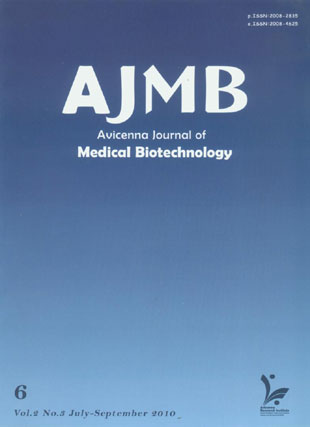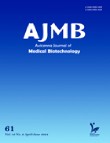فهرست مطالب

Avicenna Journal of Medical Biotechnology
Volume:2 Issue: 3, Jul-Sep 2010
- تاریخ انتشار: 1389/07/05
- تعداد عناوین: 7
-
-
Page 6
-
Page 115Due to the number of new substances coming into use every year and the increasing amounts of chemicals, which are introduced into the environment, there is a high demand for a rapid, reliable and cost-effective method for detection of developmental toxicity. To meet this challenge various in vitro techniques have been established additional to in vivo animal testing. This review introduces the techniques in existence at the moment. Requirements on an ideal in vitro teratogenicity test system are stated, and the advantages and disadvantages of the present methods are discussed.
-
Optimization of Gene Transfection in Murine Myeloma Cell Lines Using Different Transfection ReagentsPage 123Purification and isolation of cellular target proteins for monoclonal antibody (MAb) production is a difficult and time-consuming process. Immunization of mice with murine cell lines stably transfected with genes coding for xenogenic target molecules is an alternative method for mouse immunization and MAb production. Here we present data on transfection efficiency of some commercial reagents used for transfection of murine myeloma cell lines. Little is known about transfectability of murine myeloma cell lines by different transfection reagents. Mouse myeloma cell lines (SP2/0, NS0, NS1, Ag8, and P3U1) were transfected with pEGFP-N1 vector using Lipofectamine 2000, jetPEI and LyoVec commercial transfection reagents in different combinations. The transfection permissible HEK293-FT cell line was used as a control in transfection procedure. Transfected cells, expressing the Enhanced Green Fluorescent Protein (EGFP), were analyzed by flow cytometry 48 hrs post transfection. Our results showed transfection efficiency of 71%, 57% and 22% for HEK293-FT, 5.5%, 3.4% and 1% for SP2/0, 55.7%, 21.1% and 9.3% for NS0, 8.2%, 6% and 5.5% for NS1, 22%, 49.2% and 5.5% for Ag8 and 6.3%, 21.5% and 4.6% for P3U1 cell lines after transfection with Lipofectamine 2000, jetPEI and LyoVec reagents, respectively. Our data indicate that NS0 and Ag8 are efficiently transfected by Lipofectamine 2000 and jetPEI reagents. Finally, we propose Ag8 and NS0 cell lines as suitable host cells for efficient expression of target genes which can be used for mouse immunization and MAb production.
-
Page 131Tissue plasminogen activator (tPA) is a serine protease, which is composed of five distinct structural domains with 17 disulfide bonds, representing a model of high-disulfide proteins in human body. One of the most important limitations for high yield heterologous protein production in Escherichia coli (E. coli) is the expression of complex proteins with multiple disulfide bridges. In this study the combination of two distinct strategies, manipulated cytoplasm and native periplasm, was applied to produce the functional full length tPA enzyme in E. coli. Using a PelB signal peptide sequence at 5'' site of tPA gene, the expression cassette was prepared and subsequently was transformed into a strain with manipulated oxidizing cytoplasm. Then the induction was made to express the protein of interest. The SDS-PAGE analysis and gelatin hydrolysis confirmed the successful expression of functional tPA. The results of this study showed that complex proteins can be produced in E. coli using the cumulative power of both cytoplasm and periplasm.
-
Page 137A major group of drugs that have been approved for the therapy of systemic fungal infections are polyene antibiotics. Amphotericin B (AmB), one of the polyene antibiotics, has been used to treat serious systemic fungal infections by binding to sterols such as ergosterol in fungal cells membrane, and is believed to form pores in the membrane and create a transmembrane ion-channel. Since all eukaryotic cells contain sterols, using AmB can cause toxicity in mammalian cells; this is the most serious unwanted side effect. Therefore, there is still a need to develop suitable antifungal compounds to be entered in the drug development pipeline. In this study, we report the screening of various compounds from the Enhanced NCI database against ergosterol and cholesterol as receptors. The strategy employed is divided into two categories, screening and docking, respectively. Screening was performed using structure search based on AmB and molecular constraints to filter compounds with physico-chemical properties similar to the polyene macrolid antibiotics. The selected compounds were docked and scored to identify structurally novel ligands that make similar interactions to AmB. Our screening approach identified several molecules with high ranking criteria mentioned above. Among these compounds, two molecules, NSC 89270 and NSC 62792 were tested for their bioactivity against three fungal strains using broth microdilution assay that presented to have moderate antifungal activity against tested fungi. Thus, they could be possible lead compounds that grant further research on them to improve their potency and compare their mechanism of action in comparison to AmB.
-
Page 145Molecular epidemiology analyses are frequently used in determining epidemiology of tuberculosis. Recently, Mycobacterial Interspersed Repetitive Unit Variable Number Tandem Repeat (MIRU-VNTR) and Spoligotyping has become an important method, as it allows high-through put, discriminatory and reproducible analysis of clinical isolate. The purpose of this study is to compare techniques of “MIRU-VNTR” versus “MIRU-VNTR and Spoligotyping” together for study of genetic pattern of Mycobacterium tuberculosis (M. tuberculosis) strains. Sixty M. tuberculosis (MTB) isolates were selected (30 susceptible, 30 multi-drug resistant) for this study. Thereafter, the «MIRUVNTR and Spoligotyping» were performed to identify their genetic patterns. The frequency of unknown genetic pattern of MTB was compared using technique of “MIRU-VNTR” alone versus “MIRU-VNTR and Spoligotyping” together. The MIRU-VNTR allelic diversity at each of the loci was calculated by Hunter – Gaston Discriminatory Index (HGDI). Based on differentiation index of all strains 10, 16, 26, 31 and 40 loci were identified as the most distinctive (HGI ≥ 0. 6) and 2, 4, 20 and 24 as the weakest distinctive locus (HGI ≤ 0. 3). By using MIRU-VNTR technique 38% (n= 23) of isolates could not be typed, whereas by applying «MIRU-VNTR and Spoligotyping» togetheronly 15% (n= 9) of isolates remained unknown (p = 0. 004). For sensitive strains, the difference was significant (67% vs. 90%, p = 0. 028), but only marginally significant for drug resistant strains (57% vs. 80%, p = 0. 052). The discrimination power of 12-locus MIRU-VNTR and Spoligotyping was equal to that of MIRU-VNTR analysis. If appropriate loci are added to the standard MIRU analysis, MIRU-VNTR genotyping could be a valuable tool for strain typing and epidemiological research of M. tuberculosis. With this approach amore clear understanding about genetic pattern of MTB can be achieved.
-
Page 153Alzheimer''s disease (AD) is a genetically heterogeneous neurodegenerative disease and Late-Onset type (LOAD) is the most common form of dementia affecting people over 65 years old. CALHM1 (P86L) encodes a transmembrane glycoprotein that controls cytosolic Ca2+ concentrations and Aβ levels and P86L polymorphism in this gene is significantly associated with LOAD in independent case controls in a number of studies. This study was performed to determine whether this polymorphism contributes to the risk for LOAD in Iranian population. One hundred and forty one AD patients and 141 healthy controls were recruited in this study. After extraction of genomic DNA, the genotype and allele frequencies were determined in case and control subjects using PCR/RFLP method. The statistical analysis showed a significant difference in the heterozygote genotype frequency in case and control groups and polymorphic allele had a protective role between two groups. Also after stratifying the subjects by their APOE-ε4 status, no significant association was observed. Our study suggests that P86L polymorphism could be a protective factor for late-onset Alzheimer''s disease (LOAD) in Iranian population. However, to confirm these results, further study with a bigger sample size may be required.


